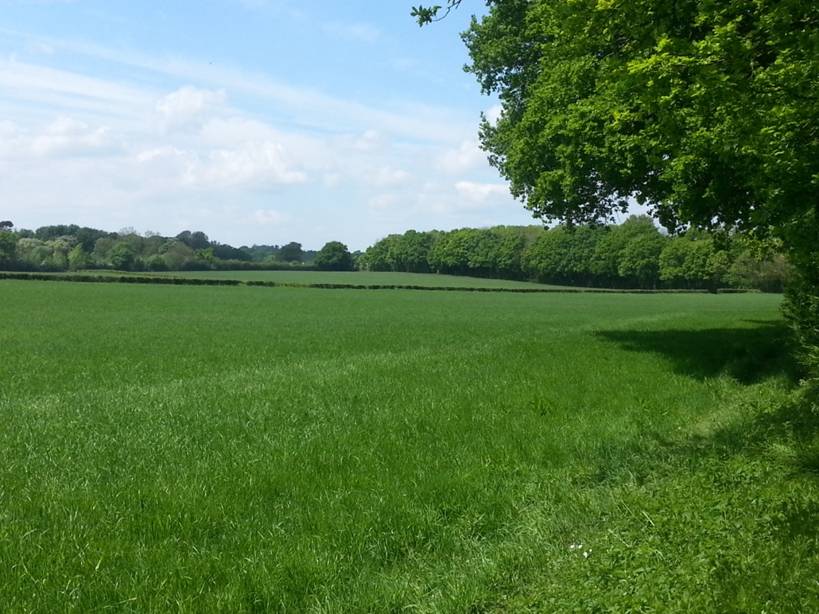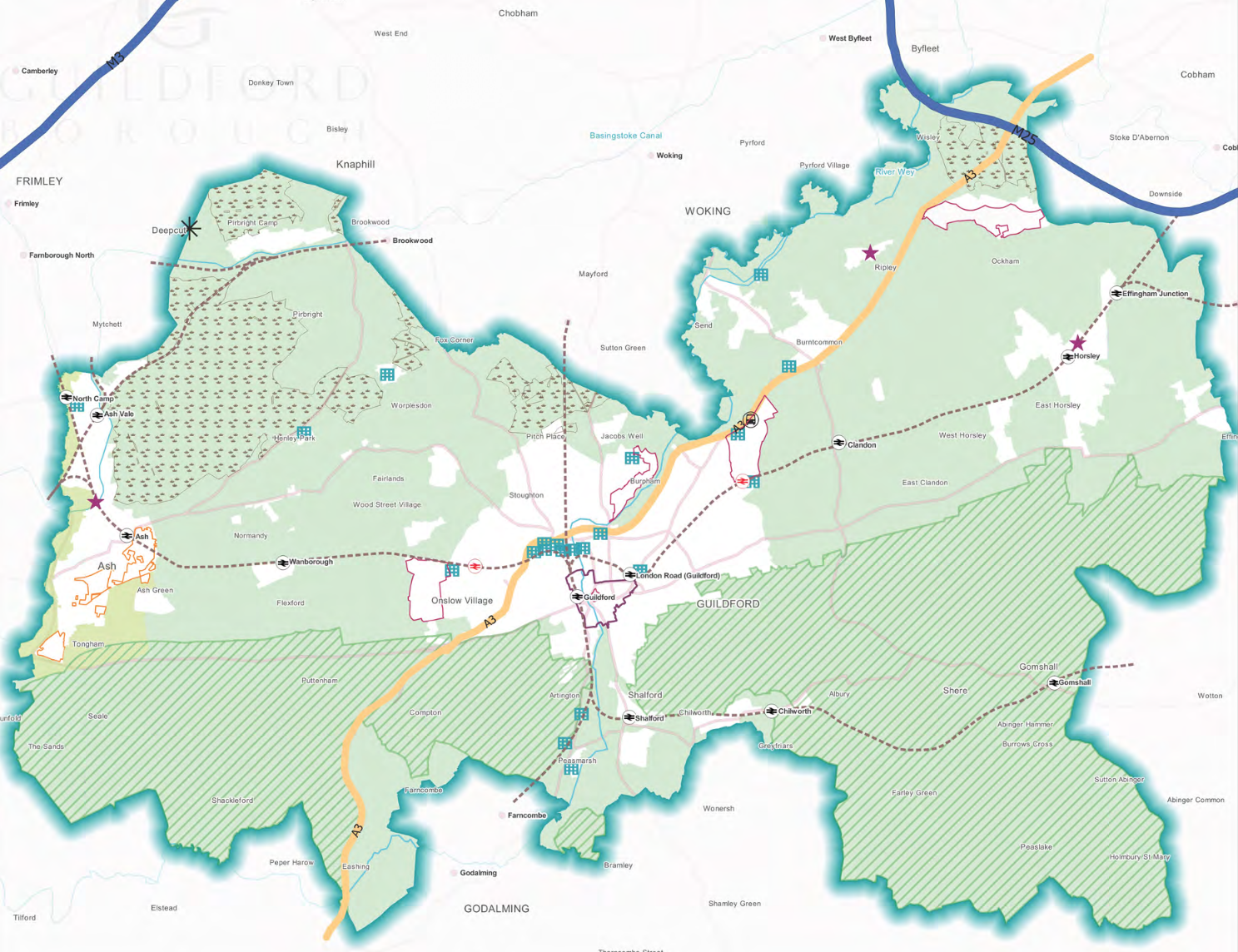 Abraham Lincoln
If given the truth, the people can be depended upon to meet any national crisis...
Abraham Lincoln
If given the truth, the people can be depended upon to meet any national crisis...
 Guildford news...
for Guildford people, brought to you by Guildford reporters - Guildford's own news service
Guildford news...
for Guildford people, brought to you by Guildford reporters - Guildford's own news service
Opinion: 20 Reasons Not to Build on Green Fields
Published on: 26 Jan, 2023
Updated on: 27 Jan, 2023
By David Roberts
What’s the difference between a field and a piece of derelict urban land? Not much from a developer’s point of view – except that the field is likely to be cheaper and easier to build on.
Many people agree. After all, it is argued, we’ve got to build somewhere – we need more affordable houses – and progress is progress.
 Wrong. It’s not hard to demonstrate that there is no link between building and affordability, at least in the South East.
Wrong. It’s not hard to demonstrate that there is no link between building and affordability, at least in the South East.
That is the subject of another discussion. But it’s the idea of “progress” that really needs to be put under the microscope, not least because desperate economic times have made “growth” a sacred mantra for Conservatives and Labour alike.
Little value is attached to what’s not growing, our GDP (gross domestic product). A cynic might include new housing estates in this. Building them makes money for some but they then become a non-productive store of capital into which an unhealthy slice of the nation’s wealth is sunk.
From this point of view, housebuilders are robbing the real economy.
More often, however, green fields are seen as useless empty space waiting to be built on. This undervalues the countryside as an inhabited, working environment that also embodies a wide stock of natural, social and cultural capital. By damaging or destroying this capital, thoughtless development can involve high opportunity costs.
These costs are poorly recognised in our sclerotic planning system, which is still stuck in a 1940s rut of social-democratic improvement. The National Planning Policy Framework (NPPF), for instance, recognises only five reasons to protect the green belt:
“a) to check the unrestricted sprawl of large built-up areas; b) to prevent neighbouring towns merging into one another; c) to assist in safeguarding the countryside from encroachment; d) to preserve the setting and special character of historic towns; and e) to assist in urban regeneration, by encouraging the recycling of derelict and other urban land.”
All laudable aims, but nothing much else counts in planning decisions.
This is too narrow for a world hurtling towards climate catastrophe and the planet’s sixth great extinction – especially as the latter is due to include us!
A fuller list of actual and potential assets or services threatened by the spread of new housing would have to include:
- Agriculture, forestry and horticulture
- Food security
- Rural business and crafts
- Mineral extraction
- Urban cooling
- Water catchment and supply
- Flood defence
- Noise limitation
- Air pollution control
- Light pollution minimisation
- Carbon storage and sequestration
- Biodiversity
- Recreation and tourism
- Land for parks, burial grounds and other public uses
- Archaeological heritage
- Film and other arts locations
- Civil emergency evacuation and assembly areas
Volumes could be written about each of these; see, for instance, the brilliant 2021 Dasgupta Review on the economics of biodiversity.
But there are three more assets which are harder to sum up but no less concrete:
18. Natural heritage, historical landmarks, traditional views, sightlines and – yes – beauty. All things that we appreciate in a fuzzy way but which add up to a powerful sense of space and place and which ground us in who we are. Aesthetic value is real and not imaginary.
19. Public health and wellbeing, both physical and psychological. The NPPF grudgingly acknowledges these benefits but surely, post-Covid, they deserve to be quantified and factored more sharply into planning decisions.
20. Promotion of social equality based on the ability to share space, public or private, with others.
No one doubts that growing inequality is a damaging issue in advanced economies, or can fail to be uneasy about the spread of gated neighbourhoods, privately policed shopping malls or quarters like Canary Wharf, where surveillance is intense and access by non-conforming individuals, especially the poor, is discouraged.
So much of what we used to have in common is still being privatised and commoditised. Some perceive a historic “loss of the commons” on a par with 16th-century enclosures, gradually turning us from free citizens into compliant consumers.
So who are the real champions of progress? Go-for-growth developers and their political cheerleaders, or rural folk stigmatised as “Nimbys”?
Open fields, like those at the former Wisley airfield, tick many of the twenty boxes above. Yet plans for 2,000 new homes there have provoked far less controversy than for 400 on a derelict urban site in North Street.
Why? Because nature provides most of the twenty ecosystem services listed for free. They therefore count for too little in many people’s minds and are easily squandered, even though they make up much of society’s true wealth.
They deserve to be treated as quantifiable, investible assets whose inclusive value down the generations often outweighs mere bricks and mortar. When will public and planners start to recognise and evaluate them properly?
Responses to Opinion: 20 Reasons Not to Build on Green Fields
Leave a Comment Cancel reply
Please see our comments policy. All comments are moderated and may take time to appear. Full names, or at least initial and surname, must be given.Recent Articles
- Lidl Planning a New Supermarket At Former County Council Offices
- Pedestrian Seriously Injured On Farnham Bypass – Police Appeal For Witnesses
- New Housing Planned To Replace Stables On Edge Of Wood Street Village
- Debt Charity’s New Report on State of Poverty in the South East and Help Available for People
- Local Government Reorganisation ‘A Great Opportunity To Start from Scratch’
- Notice: Poetry Competition – Enter by November 8
- Community Survey Planned To Discuss Future of the Troubled Electric Theatre
- 2025 Services of Remembrance to Honour our War Dead
- No Promise of A Mayor for Surrey
- Letter: This Decision Is an Outrageous Stitch-up



Recent Comments
- RWL Davies on No Promise of A Mayor for Surrey
- John S Green on ‘Disaster in the Making’: Residents React with Anger and Distrust
- Amari Hawthorne-Bailey on Memories Of Queen Elizabeth Barracks And The Women’s Royal Army Corps
- Patrick Bray on It’s Two Unitaries for Surrey – SoS Says It Is Best Option for Financial Sustainability
- Mary English on Electric Theatre In Crisis As Financial Pressures Hit – Annual Loss of Over £250k
- Jackie Montague on Dragon Review: 2:22 A Ghost Story – Yvonne Arnaud Theatre
Search in Site
Media Gallery
Cllr Townsend on Waverley’s CIL Issue
August 27, 2025 / Comments Off on Cllr Townsend on Waverley’s CIL Issue / Read MoreMP Zöe Franklin Reviews Topical Issues
August 27, 2025 / Comments Off on MP Zöe Franklin Reviews Topical Issues / Read MoreMP Hopes Thames Water Fine Will Be ‘Final Nail in Its Coffin’
August 27, 2025 / Comments Off on MP Hopes Thames Water Fine Will Be ‘Final Nail in Its Coffin’ / Read MoreNew Guildford Mayor Howard Smith
August 27, 2025 / Comments Off on New Guildford Mayor Howard Smith / Read MoreA New Scene for a Guildford Street
August 27, 2025 / Comments Off on A New Scene for a Guildford Street / Read MoreDragon Interview: Sir Jeremy Hunt MP on His Knighthood and Some Local Issues
August 27, 2025 / Comments Off on Dragon Interview: Sir Jeremy Hunt MP on His Knighthood and Some Local Issues / Read MoreDragon Interview: Paul Follows Admits He Should Not Have Used the Word ‘Skewed’
August 27, 2025 / Comments Off on Dragon Interview: Paul Follows Admits He Should Not Have Used the Word ‘Skewed’ / Read MoreDragon Interview: Will Forster MP On His Recent Visit to Ukraine
August 27, 2025 / No Comment / Read MoreDragon Interview: Fiona Davidson on the ‘Devolution’ Proposals for Surrey
August 27, 2025 / No Comment / Read More













Jules Cranwell
January 27, 2023 at 8:23 am
Well, I can’t argue with any of that. I can’t see that anyone could, apart from the Tory group which handed down their despised Local Plan in their death throes.
On point 19, Public Health and Wellbeing. A recent report illustrated the benefits of green spaces to mental health, particularly of the young. Their mental health problems have increased out of recognition in recent years. Destroying even more green spaces can only exacerbate the issue.
A Walker
January 27, 2023 at 1:55 pm
There won’t be any young people left in Surrey if there are no new houses built for them to live in.
Jules Cranwell
January 28, 2023 at 3:48 am
Mr Walker needs to come and look at the houses being built on what used to be green belt. They are all executive homes. None are affordable as first homes for the young, or for key workers.
David Roberts
January 28, 2023 at 3:44 pm
Why can’t more young people afford to live in Guildford? Because it’s cheaper for developers to build big houses in the countryside.
The Tory Local Plan colludes with them in this. But most young people want to live in town where the jobs and infrastructure are. Hence big new housing estates are appearing in the Horsleys while North Street is refused planning permission.
This is all back to front. There will be no financial incentive to regenerate the town until the countryside is put off limits.